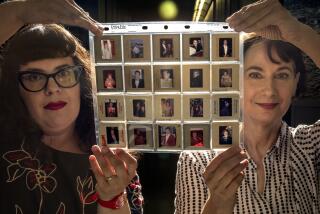Pages Out of Past : Collection of Rare Volumes at San Diego Library Tells the History of Books
Julius Wangenheim believed that a great deal could be gained by just browsing among books.
When he died in 1942, Wangenheim left that philosophy behind in the form of a book collection at the San Diego Public Library downtown.
But you can’t just drop by and leaf through the collection. Browsing is more restricted in the Wangenheim Room than among the general stacks in the library. An appointment is necessary.
The 8,986-volume collection traces the development of books through the ages, spanning 4,000 years beginning with Babylonian clay tablets from 2300 B.C.
There are original examples of Egyptian papyrus, vellum manuscripts, lacquered palm leaf books from India, Chinese silk scrolls and early handmade papers from Japan.
There are works from early European presses as well as 19th- and 20th-Century English and American presses. The Dove’s Bible, Kelmscott Press works and Grabhorn Press editions of Shakespeare are the most notable.
Visually, the books are works of art. Some are bound in wood or velvet and laced with gold- and silver-threaded embroidery. One has mother-of-pearl worked into the wood binding.
Painted Edges
A special shelf holds a collection of miniature books, none of which exceeds three inches in height. Some are only a quarter-inch-thick and look like they were meant for dolls’ houses.
The room houses the second largest collection of “fore-edge” paintings in a public library and the fourth largest overall in the United States. These books have hand-painted edges that portray landscape watercolors when the pages are fanned. There are 30 that show two separate watercolor paintings--one when the book is fanned from front to back, another when it is fanned the other way. There are 155 books showing a watercolor painting when fanned in one direction.
These are just a few of the treasures the avid bibliophile collected. Wangenheim, a successful San Diego banker who was born in San Francisco, collected rare books for 20 years before his death. His wife left the collection to the public library when she died in 1947.
Eileen Boyle, the librarian who works in the Wangenheim Room, said the man was always a collector.
“He collected stamps when he was 8 years old and sold that collection in 1899 to buy Klauber-Wangenheim stock, a family wholesale grocery business in San Diego,” she said. “He invested his interest from the stock in collecting books.”
Boyle quoted from Wangenheim’s autobiography as he described the Wangenheim collection as “My most complete collection of the history of printing and writing.”
Gifts have been added to the collection since that time. The library acquired Edward Curtis’ rare series of volumes and photographs titled, “The North American Indian”--one of 500 sets of a limited edition. Another gift of an exquisitely detailed needlepoint bookmark once belonging to Kate Sessions symbolizes the richness and value in reading.
Students interested in Medieval history, scholars interested in calligraphy, printers interested in binding and paper-making, graphic artists interested in design and gallery-enthusiasts are typical kinds of people who visit the room, Boyle said.
Tight Security
“Usually they are from the San Diego area, although we do get calls from various universities across the country from people interested in what we have,” she said.
Mary Allely, supervisor of the library’s Special Collections, said studying original documents provide enriching supplements to modern-day textbooks that refer to Medieval music, for example.
“They can study Medieval documents in their original forms,” she said.
Boyle estimated the library’s Special Collections, which include the California Room and Newspaper and Genealogy rooms in addition to the Wangenheim Room, to be worth about $500,000. Allely says the Wangenheim Room is maintained at 70 degrees and is kept under tight security.
“These special collections are separate from other books in the library because special collections need special attention and cataloguing,” she said. “Rare books are like paintings nowadays. People collect them because they’re aesthetically beautiful.”
More to Read
Sign up for our Book Club newsletter
Get the latest news, events and more from the Los Angeles Times Book Club, and help us get L.A. reading and talking.
You may occasionally receive promotional content from the Los Angeles Times.








